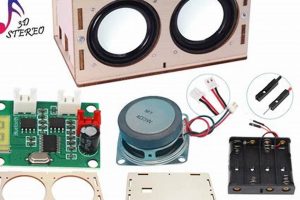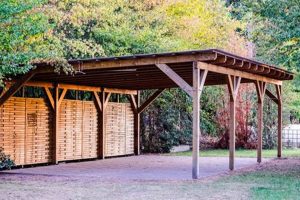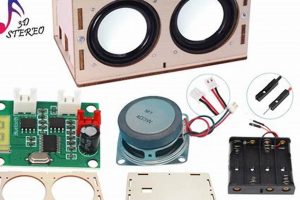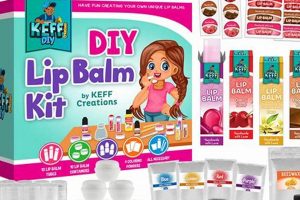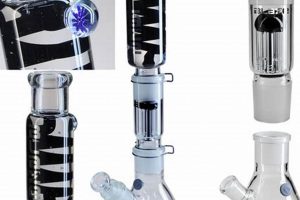An assembled ecosystem within a contained environment, often glass, provides a miniature, self-sustaining garden. These pre-packaged sets include the necessary components for constructing such a system, typically encompassing a vessel, substrate, drainage materials, activated charcoal, decorative elements like stones or moss, and small plants suitable for enclosed conditions. For instance, a package might contain a glass jar, pebbles, potting soil, sphagnum moss, a small fern, and decorative sand.
The appeal of these setups stems from several factors. They offer a manageable entry point into horticulture, demanding minimal maintenance once established. The enclosed nature of the system creates a humid environment, reducing the need for frequent watering. Furthermore, these creations can serve as aesthetic enhancements to interior spaces, bringing a touch of nature indoors. Historically, enclosed botanical gardens have fascinated scientists and hobbyists alike, demonstrating the principles of ecological balance in a simplified and accessible format.
The following sections will delve into the specific considerations for selecting the appropriate container, understanding the crucial role of substrate composition, outlining the steps involved in constructing a balanced ecosystem, and exploring suitable plant species for thriving in a confined setting.
Terrarium Assembly and Maintenance Guidelines
The subsequent recommendations aim to optimize the success and longevity of enclosed miniature ecosystems, focusing on critical aspects of construction and ongoing care.
Tip 1: Select an Appropriately Sized Vessel: The chosen container must accommodate the root systems of the selected plant species and allow for adequate air circulation. Overcrowding contributes to fungal growth and hinders proper development. Consider a vessel with a minimum diameter of 15 centimeters for small plants.
Tip 2: Prioritize Proper Drainage: A drainage layer composed of gravel or pebbles prevents waterlogging, which can lead to root rot. Ensure this layer occupies approximately one-fifth of the container’s volume.
Tip 3: Utilize Activated Charcoal: A thin layer of activated charcoal above the drainage layer filters impurities and reduces the development of unpleasant odors. This material is particularly crucial in closed terrarium environments.
Tip 4: Employ a Well-Draining Substrate: A suitable substrate mixture consists of potting soil, peat moss, and perlite or vermiculite. This combination provides essential nutrients and adequate aeration for root growth. Avoid using garden soil, as it may contain pests or diseases.
Tip 5: Carefully Select Plant Species: Opt for slow-growing, shade-tolerant plants that thrive in humid environments, such as ferns, mosses, and small succulents. Research the specific needs of each plant to ensure compatibility within the enclosed ecosystem.
Tip 6: Control Moisture Levels: Water sparingly, allowing the substrate to dry slightly between waterings. Overwatering is a common cause of plant failure. Monitor condensation levels inside the container; excessive condensation indicates overwatering.
Tip 7: Provide Adequate Light: Position the terrarium in a location that receives bright, indirect sunlight. Direct sunlight can scorch the plants. Supplemental artificial lighting may be necessary in environments with limited natural light.
Adhering to these guidelines will significantly enhance the probability of establishing a thriving and aesthetically pleasing miniature ecosystem. Careful planning and attentive maintenance are key to long-term success.
The following sections will address troubleshooting common problems encountered during terrarium maintenance, providing practical solutions to ensure the continued health and vitality of the contained environment.
1. Vessel Selection
The choice of container is fundamental to the success of an enclosed miniature ecosystem. It dictates the available space for plant growth, influences humidity levels, and significantly impacts the overall aesthetic of the resulting setup. Careful consideration must be given to size, shape, material, and accessibility when selecting a suitable enclosure.
- Size and Scale
The containers dimensions must correspond to the intended plant selection. Overcrowding limits root development and air circulation, potentially leading to fungal growth and stunted growth. Conversely, an excessively large vessel for a small plant creates an unbalanced aesthetic and may make it difficult to maintain appropriate humidity levels. Miniature landscapes benefit from smaller containers, while larger displays accommodate a greater diversity of plant life.
- Material Properties
Glass is the preferred material for enclosed ecosystems due to its transparency, allowing for maximum light penetration. It is also inert, preventing the leaching of harmful substances into the soil. Plastic containers, while lighter and less prone to breakage, may scratch easily and can potentially leach chemicals over time. Consider the long-term implications of the chosen material on plant health and overall aesthetics.
- Shape and Accessibility
The shape of the container influences light distribution and air circulation within the ecosystem. Wide-mouthed containers facilitate easy planting and maintenance, while narrow-necked vessels may require specialized tools for assembly and pruning. Consider the practical aspects of accessing the interior for ongoing care when selecting the container’s shape.
- Open vs. Closed Systems
The choice between an open or closed vessel defines the level of humidity and maintenance required. Open systems allow for greater air circulation, necessitating more frequent watering. Closed systems create a humid environment, reducing watering frequency but increasing the risk of fungal growth if not properly ventilated. Understand the environmental conditions associated with each type to select suitable plant species.
Ultimately, the selection of an appropriate vessel is a crucial step in establishing a thriving and visually appealing closed miniature ecosystem. It serves as the foundation upon which the entire environment is built, directly influencing the health and longevity of the contained plant life. Balancing aesthetic preferences with practical considerations ensures a sustainable and enjoyable horticultural experience.
2. Substrate Composition
The substrate constitutes a foundational element within a pre-packaged terrarium. Its composition directly impacts plant health, moisture retention, drainage, and nutrient availability. The materials employed in the mixture dictate the environment within the enclosure, influencing root development and overall plant viability. A deficient or imbalanced subs
trate can lead to root rot, nutrient deficiencies, and, ultimately, plant death, despite other favorable conditions within the system.
For example, a substrate lacking sufficient drainage components, such as perlite or coarse sand, will retain excessive moisture, fostering anaerobic conditions detrimental to most plant species included in such sets. Conversely, a substrate that drains too rapidly may deprive plants of essential hydration and nutrients. Pre-packaged sets often incorporate a blend of peat moss or coco coir for moisture retention, vermiculite for aeration, and horticultural charcoal to filter impurities and reduce odors. The specific ratios of these components are critical, as variations impact the success of the enclosed environment. The efficacy of these components hinges on sourcing from suppliers that adhere to recognized horticultural standards.
In summary, proper substrate composition is non-negotiable for a thriving miniature ecosystem. Selecting a setup with a well-formulated substrate mix and understanding its role in maintaining a balanced environment are essential. Failure to recognize the practical significance of substrate properties can undermine the entire effort, regardless of other favorable factors in the terrarium environment.
3. Plant Compatibility
Within a pre-packaged ecosystem, plant compatibility is paramount for sustained vitality. The enclosed nature necessitates a careful selection of species with shared environmental needs and growth habits. An incompatible pairing can disrupt the delicate balance, leading to the decline or demise of one or more components within the system.
- Light Requirements
Different plant species possess varying light requirements. Placing a shade-loving plant alongside a sun-demanding species within a closed ecosystem will invariably result in one failing to thrive. Pre-packaged ecosystems typically necessitate selecting species that tolerate low to moderate indirect light conditions, ensuring all members receive adequate illumination without scorching more sensitive varieties. For instance, pairing a fern with a succulent would be detrimental, as the fern requires shade while the succulent thrives in bright light. Understanding each species’ light needs is crucial.
- Moisture Preferences
The humidity level within a closed ecosystem presents another critical consideration for plant selection. Some species prefer drier conditions, while others thrive in high humidity. Combining plants with disparate moisture preferences can lead to root rot in moisture-sensitive species or dehydration in those requiring drier conditions. Succulents and cacti, for example, are generally ill-suited for inclusion in systems dominated by moisture-loving ferns or mosses. Pre-packaged systems often include species with similar moisture needs to maintain a stable environment.
- Growth Rate and Size
The relative growth rate and ultimate size of plants must be considered. Vigorous growers can quickly outcompete slower-growing species, monopolizing resources and overshadowing their neighbors. Selecting plants with similar growth rates and mature sizes ensures a balanced and aesthetically pleasing system over time. Dwarf varieties or slow-growing species are often preferred to prevent overcrowding within the limited space of an enclosed miniature environment.
- Nutrient Needs
While less critical than light and moisture, differing nutrient needs can also impact long-term compatibility. Plants with high nutrient demands can deplete the available resources within the system, leaving slower-growing species malnourished. Choosing plants with similar nutrient requirements and supplementing with appropriate fertilizers, if necessary, can help maintain a healthy and balanced ecosystem. Consider slow-release fertilizers designed for enclosed environments to prevent nutrient imbalances.
Plant compatibility forms a cornerstone of successful pre-packaged ecosystem cultivation. Careful attention to light requirements, moisture preferences, growth rate, and nutrient needs ensures a harmonious and sustainable environment. Ignoring these factors can undermine the entire endeavor, leading to the decline and failure of the contained ecosystem. Therefore, thorough research and informed selection are crucial.
4. Moisture Control
Effective moisture management is a critical determinant of success for any pre-packaged enclosed miniature ecosystem. The enclosed nature of these systems necessitates a nuanced understanding of water dynamics to prevent both desiccation and over-saturation, conditions that can rapidly lead to plant decline.
- Substrate Selection and Moisture Retention
The choice of substrate directly influences water retention within the environment. Substrates high in peat moss or coco coir retain more moisture, while those with perlite or vermiculite promote drainage. A pre-packaged system should contain a substrate blend appropriate for the included plant species, balancing water retention with adequate aeration. An imbalance can lead to root rot in moisture-sensitive species or drought stress in those requiring drier conditions. For example, using a substrate designed for succulents in a closed ecosystem intended for ferns would be detrimental to the ferns’ survival.
- Ventilation and Humidity Regulation
Ventilation, or lack thereof, plays a crucial role in humidity levels. Closed systems retain moisture effectively, minimizing the need for frequent watering but increasing the risk of fungal growth if humidity becomes excessive. Open systems, conversely, require more frequent watering due to increased air circulation. The presence of a lid or opening on the pre-packaged vessel dictates the rate of moisture loss and the frequency of watering. Observing condensation levels within the system provides an indication of humidity; excessive condensation signals a need for increased ventilation or reduced watering.
- Watering Techniques and Frequency
Appropriate watering techniques are essential for maintaining optimal moisture levels. Overwatering is a common cause of plant failure, leading to root rot and fungal diseases. Conversely, underwatering results in dehydration and stunted growth. Employing a spray bottle to mist the plants and substrate evenly is preferable to direct pouring, which can disrupt the soil structure and lead to localized saturation. The frequency of watering depends on the specific plant species, the substrate composition, and the degree of ventilation. A general guideline is to allow the substrate surface to dry slightly between waterings, adjusting the frequency based on observed plant health and environmental conditions.
In conclusion, meticulous moisture control is indispensable for the long-term viability of a pre-packaged enclosed miniature ecosystem. Careful substrate selection, appropriate ventilation management, and judicious watering practices are essential skills for maintaining a balanced and thriving environment. These factors directly influence plant health, aesthetic appeal, and the overall success of the pre-packaged system.
5. Light Exposure
Light exposure constitutes a critical environmental factor governing the success and longevity of plant life within enclosed miniature ecosystems. The intensity, duration, and spectral quality of light directly influence photosynthetic rates, growth patterns, and overall plant health. The following points delineate key aspects of light management within these controlled environments.
- Photosynthetic Requirements and Light Intensity
Plants require light to conduct photosynthesis, the process by which they convert light energy into chemical energy. Insufficient light intensity limits photosynthetic rates, resulting in stunted growth, etiolation (elongated stems and pale leaves), and eventual decline. Conversely, excessive light intensity can lead to leaf scorch and photoinhibition (damage to the photosynthetic apparatus). Pre-packaged miniature ecosystems typically include plant species adapted to low to moderate light levels, mitigating the risk of overexposure. Indirect or filtered light sources are generally recommended to avoid damaging sensitive foliage.
- Light Duration and Photoperiodism
Photoperiodism refers to the physiological response of plants to the length of day or night. While less critical than light intensity in most pre-packaged miniature ecosystems, light duration can influence flowering and growth patterns. Most species included in these setups are relatively insensitive to photoperiod, allowing for stable growth under consistent light schedules. However, prolonged periods of darkness can negatively impact photosynthetic rates, necessitating adequate light exposure for a sufficient duration each day (typically 8-12 hours).
- Spectral Quality and Plant Morphology
The spectral quality of light, referring to the relative amounts of different colors (wavelengths) of light, also plays a role in plant development. Blue light promotes compact growth and chlorophyll production, while red light stimulates stem elongation and flowering. Standard household light sources emit a spectrum that is generally adequate for supporting plant growth in miniature ecosystems. However, specialized grow lights with optimized spectral outputs can enhance growth and coloration, particularly in environments with limited natural light.
- Positioning and Light Reflection
The placement of the pre-packaged miniature ecosystem relative to the light source is crucial for ensuring uniform light exposure. Rotating the ecosystem periodically prevents uneven growth and promotes symmetrical development. Additionally, utilizing reflective surfaces, such as white backgrounds, can maximize light capture and reduce shadows, enhancing the overall light environment. The physical properties of the vessel can also influence light distribution, with transparent glass maximizing light penetration compared to opaque or tinted materials.
These considerations collectively highlight the profound influence of light exposure on the health and aesthetic appeal of enclosed plant systems. Optimal lighting conditions directly contribute to photosynthetic efficiency, growth regulation, and overall plant vigor. Recognizing and managing these factors are essential for sustaining a thriving miniature environment.
6. Air Circulation
Air circulation within a self-assembled enclosed miniature ecosystem directly influences humidity levels, gas exchange, and the prevention of fungal diseases. The extent of ventilation dictates the overall stability and long-term health of the planted environment.
- Gas Exchange and Respiration
Adequate airflow facilitates the exchange of gases essential for plant survival. Plants consume carbon dioxide during photosynthesis and release oxygen as a byproduct. Conversely, during respiration, plants consume oxygen and release carbon dioxide. Stagnant air can lead to a buildup of carbon dioxide and a depletion of oxygen, inhibiting these vital processes. Limited ventilation hinders proper gas exchange, potentially leading to anaerobic conditions within the substrate and reduced photosynthetic efficiency. This is particularly important as a sealed environment has limited resources that need to be refreshed through this circulation.
- Humidity Regulation and Fungal Disease Prevention
Airflow plays a critical role in regulating humidity levels within the enclosed environment. Excessive humidity fosters the growth of fungi and other pathogens, which can decimate plant populations. Adequate ventilation reduces humidity, inhibiting the proliferation of these harmful organisms. However, excessive ventilation can lead to rapid desiccation, stressing plants and hindering their growth. Balancing airflow and humidity is essential for maintaining a healthy ecosystem. Pre-packaged sets that offer adjustable ventilation options provide greater control over the internal environment, allowing for customization based on plant needs.
- Open vs. Closed Systems: Ventilation Strategies
The presence or absence of ventilation distinguishes open and closed assembled systems. Open systems, characterized by unrestricted airflow, require more frequent watering to compensate for moisture loss. Closed systems, with limited ventilation, retain moisture more effectively but necessitate careful monitoring to prevent excessive humidity and fungal growth. Strategies for managing airflow in closed systems include periodic opening of the container to allow for gas exchange and humidity reduction. Selecting plant species appropriate for the specific type of system is crucial; moisture-loving plants thrive in closed systems, while drought-tolerant species are better suited for open environments. Ensuring airflow doesn’t cause drastic temperature changes also needs consideration.
The careful consideration of airflow dynamics directly impacts the success of a constructed enclosed plant environment. Balancing the need for gas exchange and humidity regulation with the prevention of fungal diseases is essential for creating a sustainable and aesthetically pleasing system. Recognizing the interplay between ventilation strategies and plant selection is critical for long-term maintenance and enjoyment of these miniature ecosystems.
Frequently Asked Questions
This section addresses common inquiries regarding the assembly, maintenance, and troubleshooting of pre-packaged enclosed plant environments.
Question 1: What constitutes a suitable location for a terrarium?
The selection of an appropriate location is critical for the success of any terrarium. Direct sunlight should be avoided, as it can lead to excessive heat buildup and damage to plant foliage. A location with bright, indirect light is generally recommended. The specific light requirements of the selected plant species should be taken into account when determining the optimal placement.
Question 2: How frequently should a terrarium be watered?
Watering frequency depends on several factors, including the type of terrarium (open or closed), the substrate composition, and the plant species. In general, terrariums should be watered sparingly, allowing the substrate surface to dry slightly between waterings. Overwatering is a common cause of plant failure. Monitoring condensation levels inside the terrarium can provide an indication of moisture levels; excessive condensation suggests overwatering.
Question 3: What steps should be taken if mold appears in a terrarium?
The appearance of mold indicates
excessive humidity levels. To address this issue, increase ventilation by opening the terrarium for longer periods or by creating additional air circulation. Remove any affected plant material. Consider adding activated charcoal to the substrate to help absorb excess moisture and inhibit fungal growth. If the problem persists, repotting with fresh substrate may be necessary.
Question 4: Is it necessary to fertilize plants in a terrarium?
Fertilizing plants in a terrarium is generally not required, particularly in newly established systems. The substrate typically contains sufficient nutrients to support plant growth for a period. However, over time, nutrient levels may decline. If signs of nutrient deficiency appear, such as yellowing leaves, a diluted, balanced fertilizer can be applied sparingly. Avoid over-fertilization, as this can lead to salt buildup in the substrate and damage to plant roots.
Question 5: How should overgrown plants be managed in a terrarium?
Pruning is essential for managing overgrown plants. Regularly trim any excessive growth to maintain the desired aesthetic and prevent overcrowding. Use clean, sharp tools to minimize the risk of infection. Consider removing or replacing plants that have outgrown the available space.
Question 6: What types of plants are best suited for pre-packaged terrariums?
Plants best suited for pre-packaged terrariums typically exhibit low light requirements, moderate humidity tolerance, and slow growth rates. Suitable options include ferns, mosses, small succulents, and certain species of creeping vines. Researching the specific needs of each plant before inclusion in the system is critical for ensuring compatibility and long-term survival.
In summary, successful terrarium maintenance relies on careful attention to environmental conditions, including light, moisture, and air circulation. Regular monitoring and prompt action are essential for addressing any problems that may arise.
The following section will offer guidance on creative design ideas for terrarium arrangements.
In Summary
This exploration has detailed the constituents and critical factors governing the construction and maintenance of enclosed plant ecosystems initiated via pre-packaged sets. Topics ranging from vessel selection and substrate composition to plant compatibility, moisture management, light exposure, and air circulation have been addressed. Consideration of these elements directly influences the success and longevity of the constructed environment.
Understanding the principles outlined serves as a foundation for achieving a thriving and visually engaging miniature garden. Continued observation and adaptation to the specific needs of the enclosed ecosystem will further enhance its vitality and aesthetic appeal. Prioritizing informed practices elevates the potential for sustained success within this contained botanical setting.


